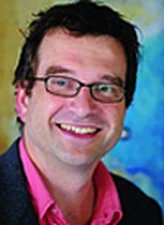Jochem Marotzke

The 2009 Fridtjof Nansen Medal is awarded to Jochem Marotzke for important research work on the oceanic time- and space-variant theremohaline circulation and the development of predictive skills in modelling it.
Jochem Marotzke developed in 1991, bringing back Henry Stommel’s model of multiple states in the thermohaline circulation, a concept of stability of the global oceanic thermohaline circulation, hypothesizing the existence of several stable modes, and implying its potential predictability. He then went on to describe several key mechanisms of the ocean circulation, such as vertical and lateral mixing, differentiation of the Ekman transport, and the role of overturning cells in the tropics and in high latitudes. For general circulation models he developed a boundary mixing scheme that allowed for non-zero conditions only near the side boundaries and in convective regions. This became recognized as obligatory for ocean general circulation models. He formulated a theory of the three-dimensional thermohaline overturning, providing the dependence of the overturning strength on latitude. Taking this further, the relationship between meridional overturning and the efficiency by which convective mixing eliminates static instability led to formulating the so-called “fast” limit with mixing scales of hours to weeks, where the meridional overturning is not rate-limited by the efficiency of the convective mixing. From 2000 on Marotzke and collaborators studied the three-dimensional dynamics of equatorially asymmetric thermohaline flow including Ekman transport. They showed that a very strong cross-equatorial transport is caused by enhanced mixing in the hemisphere with lower surface density. In practical terms this means that once the surface densities determine that North Atlantic Deep Water is the dominant ventilating source, its export rate from the North Atlantic is controlled by mixing and upwelling in the rest of the World Ocean. To prove these ideas, he initiated, developed and helped to execute the RAPID project to monitor the Atlantic overturning circulation at 26°N. This will provide the stimulation to climate scientists for at least another decade.
Jochem Marotzke is moving. After receiving a doctorate from Kiel University with a thesis supervised by Jürgen Willebrand in 1990, he began an extended stay at MIT, where he started as a post-doc with Carl Wunsch in 1990, moved from Assistant to Associate Professor of Physical Oceanography at MIT through to 1999. Back across the North Atlantic he became a Professor of Physical Oceanography, at Southampton Oceanography Centre (UK), 1999-2003, and moved on to Hamburg in 2003. Since then he has been a Director and Scientific Member of the Max Planck Institute for Meteorology, Hamburg (Germany), a Honorary Professor at the University of Hamburg since 2006, as well as the Acting Scientific Director of the German Climate Computing Centre (DKRZ).
